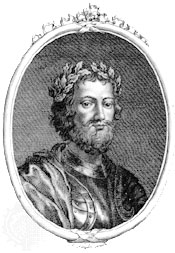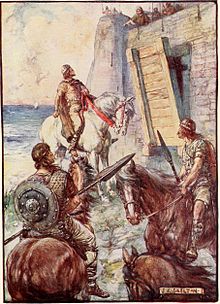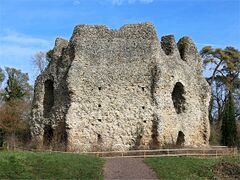Malsnectan of Scotland: Difference between revisions
No edit summary |
|||
| Line 145: | Line 145: | ||
Malsnectan was also pushed to abandon his English war after a large Norwegian raid on Moray and Ross in 1088; the raiders, after wreaking havoc in Moray, penetrated as far south as Atholl, while Norwegian galleys attacked Aberdeen and Inverness. Malsnectan led a Scottish army, along with the French and Danish forces sent to Scotland, north at the end of the year and defeated the Norwegians. In 1090, the Scottish king invaded Caithness, while a fleet of his own galleys sailed up the coast and approached the castle of Thurso, in the far north. After a two-pronged attack, Malsnectan captured Thurso and killed its defenders. In 1091, he returned to Caithness and burned the town of Dornoch. | Malsnectan was also pushed to abandon his English war after a large Norwegian raid on Moray and Ross in 1088; the raiders, after wreaking havoc in Moray, penetrated as far south as Atholl, while Norwegian galleys attacked Aberdeen and Inverness. Malsnectan led a Scottish army, along with the French and Danish forces sent to Scotland, north at the end of the year and defeated the Norwegians. In 1090, the Scottish king invaded Caithness, while a fleet of his own galleys sailed up the coast and approached the castle of Thurso, in the far north. After a two-pronged attack, Malsnectan captured Thurso and killed its defenders. In 1091, he returned to Caithness and burned the town of Dornoch. | ||
[[File:1088 ship battle.jpeg|thumb|right|240px|The naval attack on Thurso in 1090]] | [[File:1088 ship battle.jpeg|thumb|right|240px|The naval attack on Thurso in 1090]] | ||
In 1092 Malsnectan sailed to the Western Isles to arrest Gunnar | |||
Revision as of 17:46, 15 January 2023
| Malsnectan | |
|---|---|
 Malsnectan depicted in a later century | |
| King of Scots | |
| Reign | 8 May 1069 - 17 November 1122 |
| Predecessor | Malcolm III |
| Successor | Lulach II |
| Born | 1048 Scotland |
| Died | 17 November 1122 (aged 74) Perth, Scotland |
| Burial | Scone Abbey |
| Consort | Maria of Norway (m. 1066; d. 1072) Cecelia of Normandy (m. 1073; d. 1102) |
| Issue | Mary
Lulach II |
| House | of Moray |
| Father | Lulach I |
| Mother | Fenella of Angus |
Malsnectan, known as Malsnectan the Usurper (Gaelic: Máel Snechtai; 1048 - 17 November 1122) reigned as king of Scots from 1069 until his death. His reign of fifty-three years remains the longest in Scottish history, and marked the beginning of the Scoto-Norman period of foreign influence in the Gaelic kingdom of Scotland. Malsnectan conquered Galloway, Northumberland, the Western Isles, and other regions, expanding his power to exceed that of any other British ruler.
An adopted grandson of King Macbeth, Malsnectan seized the throne in 1069 after the murder of Malcolm III, who had taken the throne from the Moray family and killed Malsnectan's father. During the next fifteen years, Malsnectan brutally exterminated the entire Dunkeld dynasty to secure his own family's claim on the throne. Malsnectan's second son William, a crusader, was chosen to be king of Egypt by the pope in 1118, while his grandson Richard became duke of Flanders. Two of Malsnectan's sons, Lulach and Kenneth, succeded him in turn on the Scottish throne.
Early life
Malsnectan was born in 1048, son of Lulach of Moray, stepson of the reigning Scottish king Macbeth mac Findlaích, and Fenella of Angus, a Gaelic woman of whom little is known. When Malsnectan was an infant, his father was formally adopted by King Macbeth. Malsnectan's adopted grandfather held the Scottish throne by virtue of murder, having killed Duncan I in 1040 to take the throne, and in the early 1050s he was challenged by Duncan's son Malcolm, culminating in an English-backed invasion of Scotland in 1054. Macbeth defeated this challenge, but was mortally wounded in a second invasion three years later, dying on 15 August 1057.
Malsnectan's father Lulach was inaugurated king of Scots the following month, but Malcolm ordered his assassination at Essie on 17 March 1058 and thereafter took the throne. Malsnectan, aged ten, was taken to Moray by his mother Fenella, where they were out of Malcolm's reach. Little is known about Malsnectan's life in these years, but he maintained power as mormaer in the province, a title held by his grandfather Gillecomgain of Moray (d. 1032).
Seizure of the throne
During the early 1060s the blood feud between Malsnectan and Malcolm III probably continued, but in 1066 the two met at Dunkeld and exchanged oaths of peace, following which the king bestowed the thanage of Buchan on Malsnectan. On 29 June 1067 Malcolm III was killed at Fortingall while hunting with his half-brother Malmure, mormaer of Atholl. As the news spread through Scotland, a group of nobles loyal to Malcolm took his eldest son Duncan to Scone and proclaimed him as king.
The loyal nobles led by Murdoch, mormaer of Strathearn, invaded Moray but Malsnectan defeated them at Elgin, following up his victory by wasting and burning the fertile Clyde valley. At this crucial time Malsnectan called upon the aid of his father-in-law Harald Hardrada, king of Norway, who had conquered England earlier that year. A Norwegian fleet devastated Angus and Fife, while Malsnectan invaded Atholl, burning the towns and driving off the cattle. By the end of 1068, Duncan II's loyalists had been defeated in battle and their heartlands devastated. Malsnectan negotiated with Dubh, earl of Fife, and Ranald, bishop of St. Andrews, who agreed to endorse his inauguration at Scone.
Early reign (1069-84)
Malsnectan was inaugurated king of Scots at Scone on 8 May 1069, with a sizable group of noblemen and clerics present, indicative of their general support for his accession to end the civil strife. Malsnectan pardoned Murdoch of Strathearn and Malmure of Atholl, giving them gifts of gold to entice them to his side, and had the ex-king Duncan sent as a prisoner to the castle of Forres, stronghold of the mormaers of Moray. Malcolm III's other sons, Donald and Malcolm, escaped to Ireland. In 1070, Malsnectan marched into Atholl with an army to capture Donald, brother of Malcolm III, but he escaped to the kingdom of the Isles.
War with the Isles
In the summer of 1070 Gudrǿd Crovan, king of the Isles, launched an attack on Ross and Inverness. Malsnectan defeated the Islesmen before the gates of Inverness, slaughtering most of their war-band. However, Malsnectan's attack on the sacred island of Iona was abandoned with over a thousand Scottish casualties, a victory attributed by the defenders to St. Columba. In 1071 Malsnectan invaded Argyll, but did not achieve success and was forced to raise a new army. The castle of Dunstaffnage, with its large wooden keep and strong palisade, proved difficult to capture, as did the walled town of St. Moluag, defended by its bishop.
In 1072 Malsnectan launched a second invasion of Argyll, succeeding in gaining control over the province. In early 1073 he led a raid on Finlaggan, pillaging and burning the town. During 1073-74 Malsnectan extended his control over all of the Western Isles, thoroughly defeating Gudrǿd Crovan and driving him into Galloway, where he met with the king of Scots sometime in 1074 and negotiated peace. The resulting peace recognized Gudrǿd as king of Galloway, while Malsnectan retained the lands he had conquered.
Conquest of Galloway
The death of Malsnectan's wife Maria of Norway at Scone on 14 December 1072, after giving birth to a daughter, forced the king to briefly return from the campaign and find a new spouse to secure the succession. An embassy to France led by Uhtred, bishop of Dunkeld, led to Malsnectan's betrothal to Cecelia, daughter of William the Bastard, duke of Normandy, in the summer of 1073. Cecelia arrived in Scotland later that year and was consecrated as queen. In 1074 Malsnectan traveled to Durham to meet with Magnus Haraldsson, prince of England, with whom he dedicated a tomb to his late first wife.
In April 1075 Gudrǿd Crovan was murdered at Whithorn in Galloway, leaving the province to descend into civil war. In 1076 Malsnectan raised an army and invaded Galloway, taking advantage of the chaos, and laid siege to Gudrǿd's stronghold at Dunragit. In March 1077, having failed to starve out the garrison, the king led an assault on the castle but sustained a grevious wound, "stabbed through the cheek with a long spear" according to one chronicler, so that for many years afterwards he wore a bandage around his jaw and spoke little. Nevertheless, the Scots captured Dunragit and later that year Malsnectan led a raid on the Isle of Man.
At Christmas 1077 Malsnectan secured the submission of Donald Crovan, ruler of Galloway on behalf of the infant heir Gunnar Gudrǿdsson, in a treaty by which he was recognized as lord of Galloway. In 1079 he toured Galloway with an army to reinforce its submission. In June of that year Malsnectan arranged his own consecration as lord by Matthew, bishop of Whithorn, an unusual step underlining his determination to enforce his rule over the province.
Destruction of the Dunkeld dynasty
In 1080 Malsnectan invaded the Isle of Man after Gunnar Gudrǿdsson was deposed by a Norse rebellion and forced to flee to Ireland. In the span of a few months the king conquered the island, installing his brother-in-law Erik Svendsen, son of Svend II of Denmark, as its ruler. Malsnectan was soon confronted by a more serious challenge, prompted by the death at Forres around this time of the ex-king Duncan II. Duncan's brothers Donald and Malcolm returned from Ireland to challenge Malsnectan for the throne, supported by Murdoch of Strathearn and Malmure of Atholl, who thus betrayed their agreement with the king.
Malsnectan had a stroke of luck in September 1080 when he defeated the Dunkeld army at Scone. Donald son of Malcolm escaped with his life, but his brother Malcolm and Murdoch of Strathearn were both captured; Malsnectan ordered them both to be put to death on the field. The battle was a disaster for the Dunkeld dynasty, and Malmure of Atholl quickly came to terms with Malsnectan rather than face a similar fate. Malsnectan was ruthless in his persecution of Dunkeld loyalists; in June 1081, he defeated the young mormaer of Strathearn, Gilchrist son of Murdoch, at Cupar and personally decapitated him. After a brief siege, Malsnectan captured Perth, where Donald had been hiding, and ordered his execution on 30 December 1081.
In 1082 Malsnectan hosted a tournament at Ellon, the seat of his thanage of Buchan, at which French, Norman, Flemish, and English knights participated. Constantine mac Dubh, earl of Fife, by tradition the foremost magnate in Scotland, was killed in the tournament and Malsnectan allowed Gilbride, earl of Argyll, to appropriate the prestigious earldom for himself. This angered Malmure of Atholl, who had also hoped to acquire Fife. Around the same time, the king gave the lordship of Galloway to Erik Svendsen. Malsnectan visited Lanark in 1083 to meet with Gospatric Dunbar, lord of Lothian, probably to secure his support against Malmure.
Open war between Malsnectan and Malmure began in 1084, but was quickly ended in brutal fashion. Malsnectan gathered his warriors and laid waste to Atholl, already devastated by past conflicts. Malmure fled into the wilderness, leaving his wife and children in his stronghold of Blair Atholl. The king built a wooden siege engine and captured the hillfort, ordering Malmure's wife and children to be executed, in an act that shocked many but received little reproach. Malmure was captured later that year and drowned on Malsnectan's orders, eliminating the last member of the Dunkeld dynasty.
Middle years (1084-1107)
Malsnectan completed his dynasty's hold on the Scottish throne in 1086, when he took oaths from an assembly at Scone that his eldest son Lulach would be the next king. During this time Malsnectan was considering an invasion of northern England, spurred by the minority of Alv Magnusson, king of England, a grandson of Harald Hardrada. In 1087 he sent a Scottish embassy led by Gospatric Dunbar to the court of Philip, king of France, who agreed to support a Scottish attack on England. Buoyed by this promise, Malsnectan began mustering the Scottish host at Stirling for an invasion of Northumberland.
Invasion of England (1088)
In early 1088 Malsnectan led his army into Northumberland, burning the towns and killing many people, including women and children according to multiple chroniclers. On 13 May the Scots were defeated at Yeavering by Gyrth, earl of East Anglia, forcing them to retreat back into Lothian. During the summer, at Malsnectan's request, a small force of French knights and archers landed in Scotland; a Danish fleet sent by Harald III, king of Denmark, also arrived at Aberdeen to assist the Scots. Despite this foreign support, Malsnectan ultimately chose to abandon the English campaign after Gospatric Dunbar, probably the most important supporter of the war, died in October 1088.
War in the north
Malsnectan was also pushed to abandon his English war after a large Norwegian raid on Moray and Ross in 1088; the raiders, after wreaking havoc in Moray, penetrated as far south as Atholl, while Norwegian galleys attacked Aberdeen and Inverness. Malsnectan led a Scottish army, along with the French and Danish forces sent to Scotland, north at the end of the year and defeated the Norwegians. In 1090, the Scottish king invaded Caithness, while a fleet of his own galleys sailed up the coast and approached the castle of Thurso, in the far north. After a two-pronged attack, Malsnectan captured Thurso and killed its defenders. In 1091, he returned to Caithness and burned the town of Dornoch.
In 1092 Malsnectan sailed to the Western Isles to arrest Gunnar


